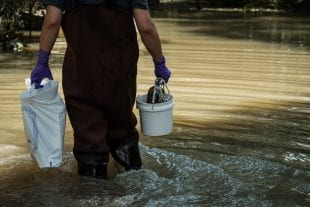Federal recovery funding after a disaster may disproportionally benefit white entrepreneurs, according to new research from Rice’s Department of Sociology.
“The Racially Unequal Impacts of Disasters and Federal Recovery Assistance on Local Self-Employment Rates” is the first local study examining patterns of racial inequality in self-employment linked to federal disaster recovery funds — specifically racially and ethnically diverse metro counties such as Harris County, Texas; Miami-Dade County, Florida; and Los Angeles County, California. The Federal Emergency Management Agency (FEMA) National Advisory Council released a report last November that prioritized equitable disaster recovery, a focus echoed by new FEMA director Deanne Criswell.
“Results from our county-level analyses during 2000 to 2010 indicate that despite their devastating impacts, more costly natural disasters increase local self-employment rates,” wrote authors Asia Bento, doctoral fellow in Rice’s sociology department, and Jim Elliott, professor of sociology and faculty affiliate at Rice’s Kinder Institute for Urban Research.
“Damages, in other words, appear to create opportunities,” they continued. “That finding is consistent with recent research showing that over time and across the nation, the numbers of both businesses and nonprofit establishments tend to increase with natural hazard damages.”
Bento and Elliott’s research finds that natural disasters on their own increase self-employment by .014 percentage points for each additional $100 million in local property damages, and when FEMA provides recovery funding, that number climbs even higher. For example, in the event of a $1 billion disaster, there was an average increase of roughly 420 additional self-employed people in the counties studied.
“That’s beyond what we would expect if no damages occurred,” the authors said. “And, if the county then received $100 million in FEMA Public Assistance, that number would increase to 897 additional self-employees; that’s beyond what we would expect with no FEMA Public Assistance.”
However, white workers benefit the most from the increase, according to the study.

Credit: Jeff Fitlow/Rice University
“When we factor in FEMA Public Assistance, we find recovery funding — not natural hazards damages themselves — drives increases in local self-employment rates, and it is white workers who benefit most strongly and consistently from those increases,” the authors wrote.
Bento and Elliott’s research also indicates that Public Assistance from FEMA, which flows through state and local agencies, may disproportionally boost privileged, white residents’ self-employment – giving them another advantage in securing business capital. The more Public Assistance funding to a county after disaster, the more white entrepreneurship rates increase.
“This outcome requires no overt conspiracy or intent,” they explained. “Business as usual leads to this result.”
Racial disparities in access to business capital may support these trends, Bento and Elliott argue. Prior research shows Black entrepreneurs — who, on average, are less wealthy than white entrepreneurs — rely heavily on their own assets to start and maintain businesses; they are denied loans twice as often as white business owners. This makes it harder to start and sustain a business in the face of a disaster.
“Overall, these findings add to growing public concern that disaster recovery has long-term implications for local economies and for the racial inequalities that structure and divide those economies,” the authors wrote. “Intentionally or not, those implications favor white workers over Latino and Black workers living in the same metropolitan counties experiencing the same levels of rising natural hazard impacts and federal recovery assistance.
“Yet, whereas white workers are able to channel these dynamics into higher self-employment rates, Black and Latino workers must fight even harder against well-documented inequities to maintain their self-employment rates despite modest capital reserves, limited access to loans, lower profit margins and concentration in more exposed sectors of the local economy,” they continued. “That resilience, in addition to rising white self-employment linked to federal recovery funding, deserves more attention as we continue to plan for future disasters.”

